The Greek god Apollo, one of the Twelve Olympians, is often represented in the figurative arts holding an ancient lyre or a contemporary stringed instrument in its stead such as the lira da braccio, vihuela, viol, violin, lute, or guitar. However, as a punishment from Zeus for killing Delphyne (or as later tradition has it, the Cyclopes) for the death of his son, Asclepius, Apollo was made to spend a year in servitude as a cowherd for King Admetus of Pherae in Thessaly, famed for his hospitality and justice. In this mortal guise, Apollo was playing the aulos when Mercury stole Admetus’ herd of cattle. Apollo subsequently received the lyre from the thief by way of compensation. Thus, as well as stringed instruments Apollo’s attributes sometimes included wind instruments, amongst them recorders.
The following depictions of Apollo associating him with the recorder or other duct flutes are drawn from the extensive enumerative iconography of the recorder presented elsewhere on this website.
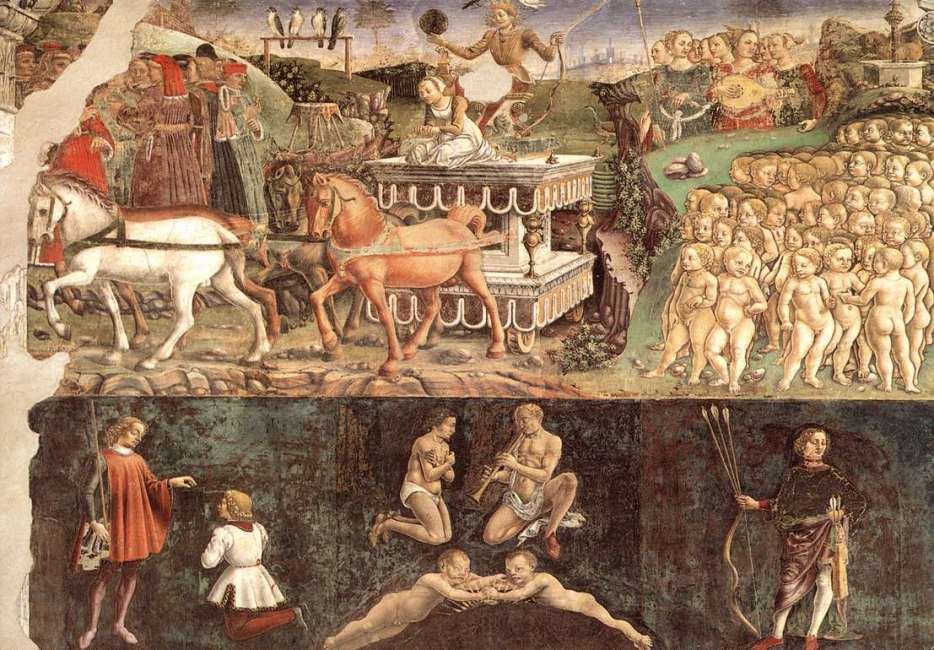
Steered by Eos (Aurora), horses drag a highly decorated cart carrying Apollo (God of light, music, hunting, healing, poetry and prophecy) triumphant, holding his bow. Across the stream behind him is a crowd of naked boy children (Apollo had many). In the background the Muses sing to the accompaniment of a lute. Beneath, in the underworld, Apollo variously plays his pipe to one of the poor souls who dwell there, heals a patient, and strides forth as a hunter with his bow and arrows, turning his back on darkness where two putti try desperately to prevent the rays of the sun from shining. The pipe is a long cylindrical recorder with a flared bell; the window/labium is shown, and the lowermost finger hole is offset.
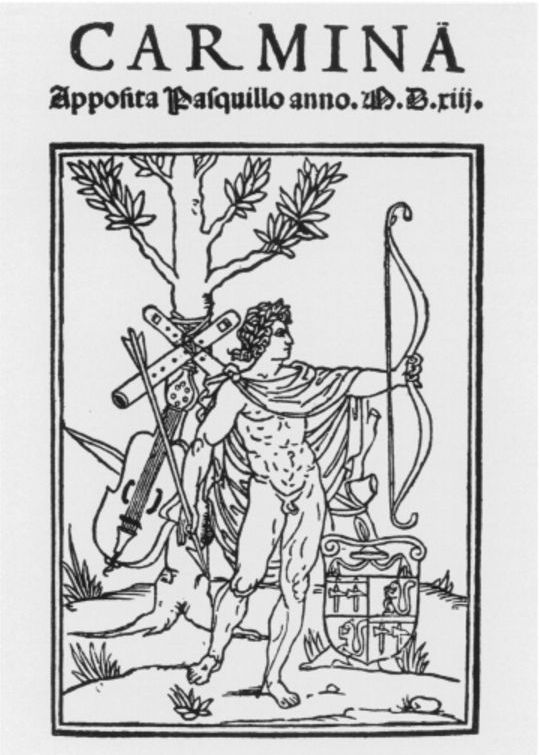
The anonymous Carmina apposita is a rare pasquinade, a prototype of satire, here celebrating the election of the humanist Giovanni di Lorenzo de Medici as Pope Leo X and anticipating his patronage of arts, literature and humanism. The verse form derives from the name Pasquillus given to a classical statue unearthed in 1501 and erected by the Italian cardinal and diplomat Oliviero Carafa in the Piazza Navona, Rome. A tradition quickly sprang up of declaiming satiric verse in front of the statue on the feast of St Mark (25 April) and affixing copies to it; in addition, each year the statue was dressed as a different pagan god. The verses began to be printed in 1509, often illustrated with a woodcut of the statue in its guise for that year, and with the arms of the cardinal who was patron of that year’s festival. Here, Apollo’s musical attributes are represented by a lira da braccio, and two stout, crossed duct flutes. One of the latter has six visible finger holes, but a seventh might be hidden by the arrow crossing it. Recorders are a distinct possibility.
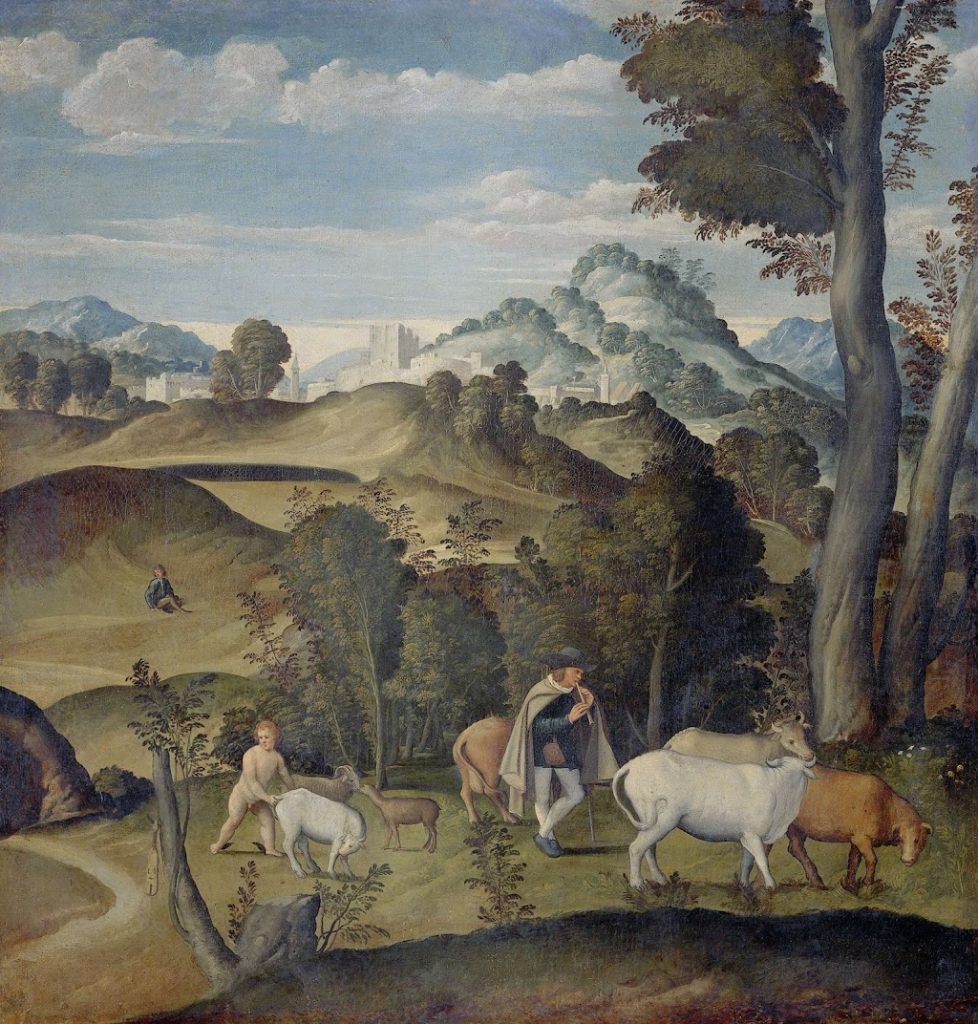
On the edge of a forest in a hilly pasture, Apollo (disguised as a shepherd), plays an alto-sized recorder with a slightly flared bell. Behind Apollo’s back, Mercury (as a child) rustles a calf from the herd. Not far off, a young lad seems to be sounding the alarm. In the distance is a walled town.
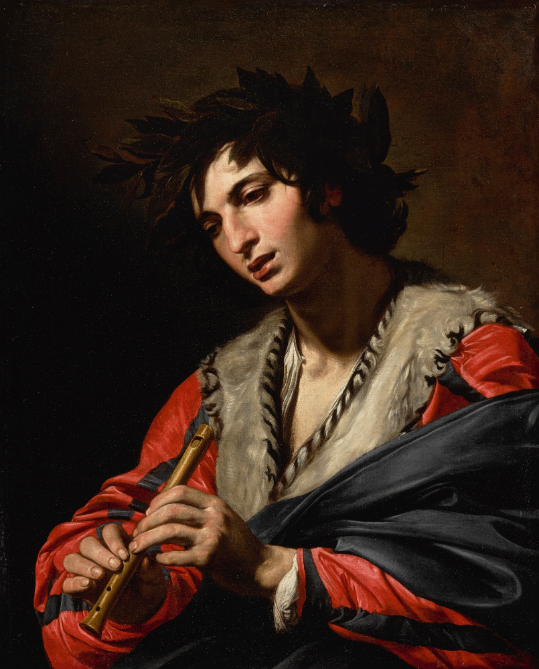
In one of a number of versions of this composition attributed to Valentin de Boulogne (1594–1632), a young shepherd in a crimson shirt and leather jacket holds a perfectly depicted cylindrical recorder with a flared bell, and with four holes for the fingers of the lowermost (right) hand clearly visible. This work has been variously attributed to Nicolas Régnier (1590–1667), and jointly to Jean de Boulogne (1594–1632) & Moïse Valentin (ca 1591–1632).
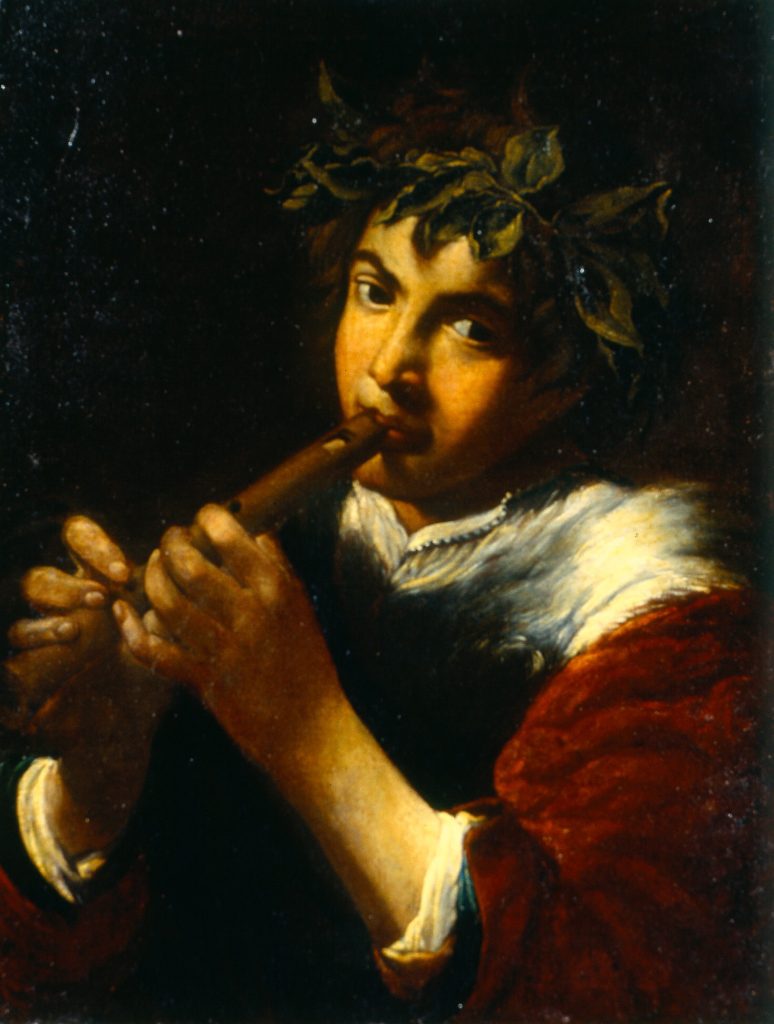
In another, a youthful shepherd wearing a laurel wreath, a crimson-sleeved jacket, and a fur jerkin plays a cylindrical duct flute with a slightly flared bell. His fingers are clumsily arrayed showing one open finger hole and another partially vented. The little finger of his lowermost (right) hand appears to be covering its hole, so this almost certainly represents a recorder. It is easy to imagine that the player is meant to represent Apollo in his role as herdsman.
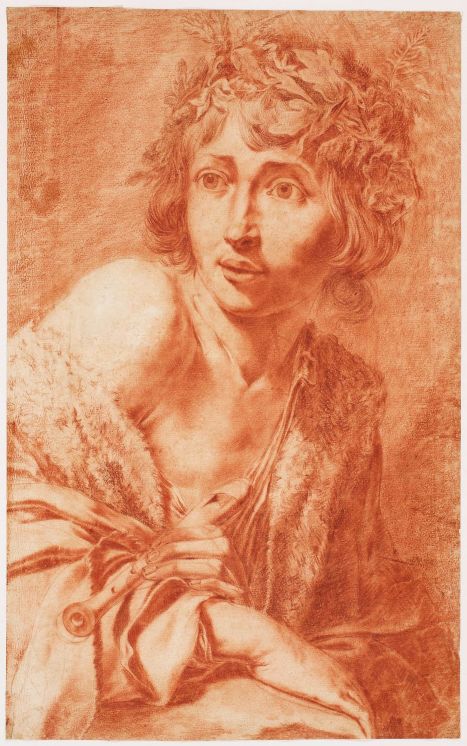
A drawing at the National Museum of Warsaw, from the now dispersed 17th century Codice Bonola, depicts a wide-eyed shepherd boy wearing a leafy wreath and holding a flared bell duct flute in his left hand. Although only two finger holes are visible, this may have been intended to represent a recorder. Possibly after a lost painting by Valentin de Boulogne, Apollo Dressed as a Shepherd.

Apollo sits dreamily tootling away on his pipe, a conical instrument played with all fingers of his lower (left) hand covering their holes, and the hint of a window/labium suggesting a recorder. Across the river behind him, a herd of cattle amble downstream, chased by Mercury in his winged helmet. One of a series of large frescoes (now transferred to canvas) that once decorated the walls of a spectacular pavilion in one of the great Italian Baroque gardens, the Villa Aldobrandini in Frascati, rebuilt by Cardinal Pietro Aldobrandini, nephew of Pope Clement VIII. Domenichino’s frescoes – two of which remain in situ – were arranged around a room called the Stanza di Apollo, which also contained a musical fountain representing Mt Parnassus, the mythical home of the Greek sun god Apollo and the Muses. Based on themes drawn from the Greek myths, the iconographical programme glorified the triumph of the Catholic Church, and the role of the Aldobrandini family in it, emphasising the superiority of the intellect over the emotions. Although Domenichino designed the pictures, much of the actual painting was done by his assistants.
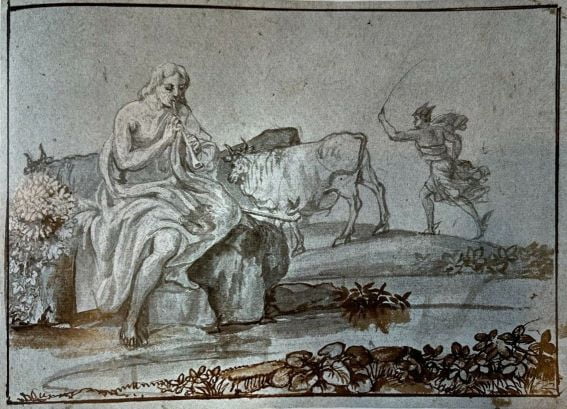
Claude Gellée, ‘Le Lorrain’ (1600–1682). Private Collection.
Sitting by a stream, Apollo, required to guard a herd of cows (the flocks of Admetus), plays a slender pipe (probably a recorder) with a slightly flared bell. In the background, Mercury is seen driving away the cattle.
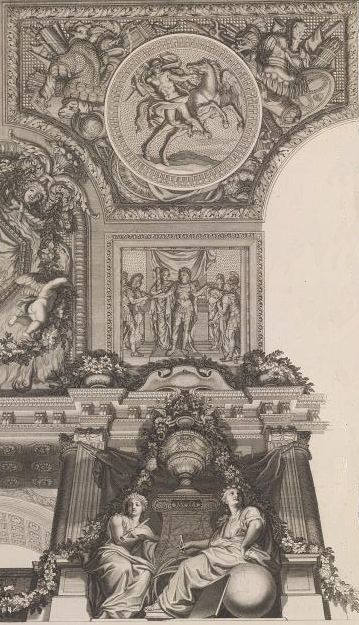
A series of six engravings meticulously depict the architecture and frescoes of the Grand Staircase of the Ambassadors painted 1677–1679, reputed to be Le Brun’s masterpiece, but destroyed in 1752 on the order of Louis XV. The engravings include personifications of four continents, the arts, and the Greek pantheon. One of these engravings depicts King Louis XIV dispensing rewards to the leaders of his armies. Above, in a circular plaque, Mercury rides Pegasus; below, Uranie (Muse of astronomy) sits on a globe holding her dividers, and Euterpe (Muse of music and lyric poetry) holds a flared-bell duct flute, probably a recorder. The royal propaganda machine strongly identified Louis XIV with Apollo, amongst other exalted mythological and historical figures. Significantly, Jean-Baptiste Lully (1632–1687) in his tragédies-lyriques twice uses recorders in scenes with Apollo and these same two Muses.
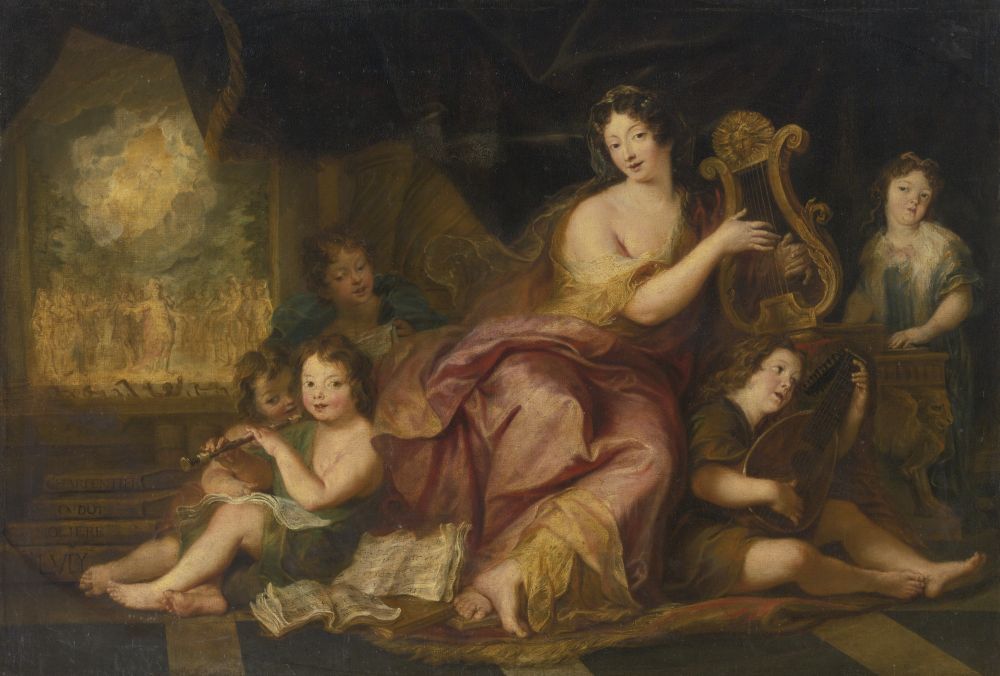
Although ostensibly an allegory of music, elements in the composition above, as well as literary and external pictorial evidence, allow us to identify it as a portrait of Mme de Maintenon with the natural children of Louis XIV. It is one of seven panels depicting the arts and sciences commissioned by author and member of the Académie Française Charles Perrault for the ceiling of his Cabinet des Beaux-Arts in the Hôtel Perrault, rue Neuve des Bons Enfants, Paris. Although the ceiling itself has been dated between 1680 and 1683, it is thought that the paintings were never installed; the building was destroyed in 1685. The Allegory of Music follows the general scheme of the other seven paintings of the arts and sciences. In the centre of the composition an attractive woman plays a classical lyre surrounded by five children, one playing a perfectly depicted baroque recorder (with ivory beak, foot and mounts), another a lute, and a third a harpsichord, instruments associated with Apollo. Behind them is a curtain, which is lifted at the left to reveal an actual stage set with figures in antique armour, and an orchestra below. It is notable that while the children are all playing modern instruments, the woman is playing a lyre of the type found in antiquity, seemingly incompatible with Perrault’s otherwise modernist viewpoint. At the top centre of the instrument is the head of Phoebus Apollo from which the Sun’s rays stream forth. This clear portrayal of the Sun God is clearly a reference to Louis XIV, the Sun King. The King had had five children with his mistress Mme de Montespan, but beginning in 1679 their relationship had begun to deteriorate. By 1680 she was in disgrace. Louis then gave the children into the care of Mme de Maintenon, his new favourite. They would have been about the same ages as the children depicted here, and Mme de Maintenon would have overseen their education, musical as well as literary. Given the long tradition for the making of music to signify emotional harmony, including them all in an Allegory of Music would have made iconographic as well as historical sense.
The remainder of the composition enlarges on the virtues of modern music. In the left corner is a stack of large volumes with the names of contemporary composers or librettists on the spines: Charpentier, Moliere, Oudot and Jean-Baptiste Lully. The last was a particular hero of Perrault’s who specifically cites him in his description of the Allegory of Music. Although he refers to opera by Lully, there is very little in the action on the stage seen at the far left that allows us to identify a specific work. It is perhaps more likely that Coypel was inspired by the contemporary livrets that included more generic illustrations of the operas in question. The theatrical scene depicted here is very similar to that above the Grand Staircase of the Ambassadors at Versailles (see above) showing King Louis XIV dispensing rewards to the leaders of his armies.
This painting appears to have been the model for Matthijs de Visch’s Portrait of the Pangaert d’Opdorp Family (1725-1745).
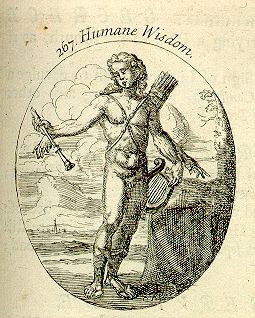
The Iconologia of Cesare Ripa (1593) was conceived as a guide to the symbolism in emblem books. It was very influential in the 17th century and went through a number of editions. There were nine Italian editions (1593, 1603, 1611, 1613, 1618, 1625, 1630, 1645, 1764–1767) and eight editions in other languages – French (1644, 1766), Dutch (1644, 1699), German (1704, 1760), English (1709, 1779). The text and the emblems included in these editions vary greatly, and later editions use Ripa’s idea, rather than following his text.
The commentary accompanying the above image by Fuller in the 1709 edition of the Iconologia reads:
A youth with four Hands, and four Ears; A Quiver by his Side, a Recorder in his right Hand, and a Lyre in the other, sacred to Apollo. The Hands denote Use and Practice, necessary to get Wisdom, beside Contemplation. The Ears, that to hear others is requisite. The Flute and Quiver, that one should not be too much taken in hearing Encomiums of oneself, nor unprovided, in case of Offense.
The recorder in this image is an alto of baroque style with a flared bell. Since its decidedly Apollonian owner has four hands he would doubtless have been able to play both recorder and lyre together!
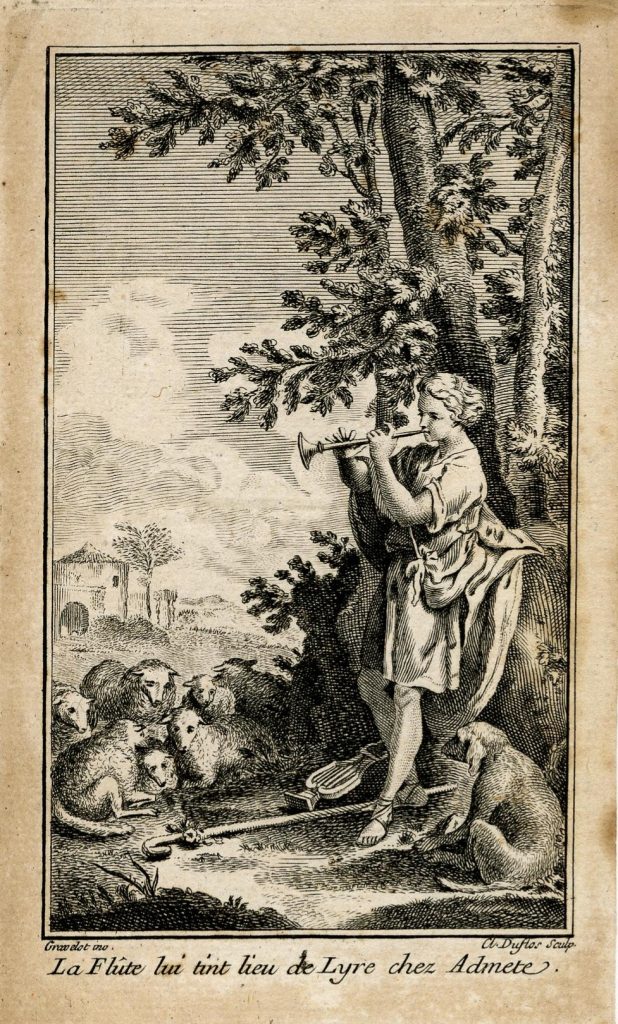
The above illustration comes from Comédiens, in the eighth volume of Bernard Le Bovier de Fontenelle’s Oeuvres, 10 vols (Paris: Brunel, 1752). Disguised as a shepherd, his dog beside him, the young Apollo stands at the edge of the woods on the right. He plays a wind instrument with a flared bell to a flock of sheep lying resting at the left. A dog sits at the lower right, and a shepherd’s crook and a lyre lie on the ground before him. A few buildings are in the left distance. The lyre in the etching identifies the shepherd as Apollo, but in this image the lyre has been discarded in favour of the ‘flute’ which he plays while he watches over the flock belonging to Admetus. If we take the French caption at its word then the instrument must represent a flûte à bec, but no window/labium is visible, and it looks rather more like a shawm.
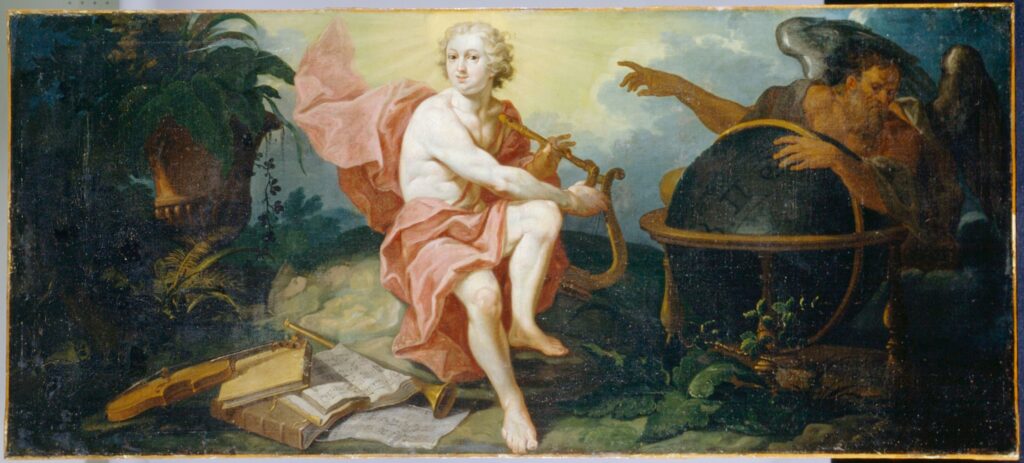
Seated on a hillock in wild landscape Apollo bathed in light holds his lyre in one hand and a perfectly depicted three-piece baroque alto recorder in the other; at his feet are a straight trumpet, books, music and a violin Opposite him, Father Time crouches over a globe pointing towards Apollo but gazing away from him into the darkness.
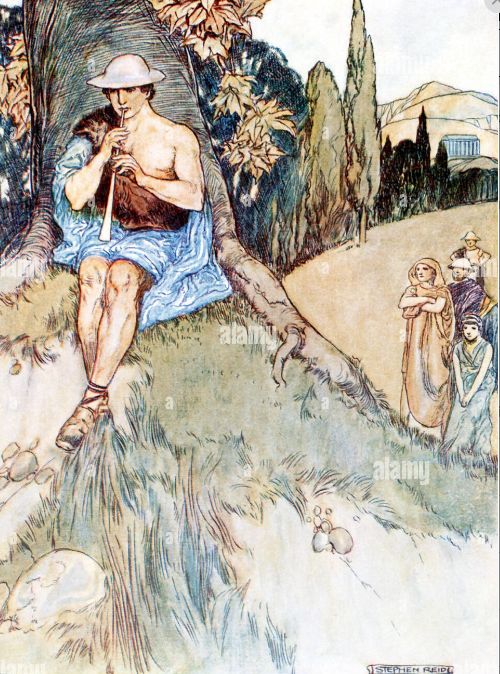
In this illustration from Old Greek Folk Stories Told Anew, by Josephine Preston Peabody (Harrap 1911), Apollo sits at the foot of a tree on a grassy knoll, playing a slender, flared, vertical pipe of tenor size, right hand uppermost. Details of his instrument are completely lacking, but it just might represent a recorder. In a clearing behind Apollo, four people are listening to his playing. And in the distance can be seen a temple of some kind, perhaps that dedicated to Apollo at Sicyon.
According to the mythographers, Athena, while playing the flute, saw her own reflection in water and, observing the distortion of her features, threw away the instrument in disgust. It was picked up by the satyr Marsyas, who no sooner began to blow through it than the flute, inspired by the breath of a goddess, emitted of its own accord the most beautiful music. Elated by his success, Marsyas was rash enough to challenge Apollo to a musical contest, the conditions of which were that the victor should do what he pleased with the vanquished. The Muses, or, according to others, the Nysaeans, were the umpires. Apollo played upon the lyre, and Marsyas upon the flute; and it was not till the former added his voice to the music of his lyre that the contest was decided in his favour. As punishment for the presumption of Marsyas, Apollo bound him to a tree, and flayed him alive. His blood was the source of the river Marsyas, and Apollo hung up his skin in the cave from which that river flows. His flute was carried by the river Marsyas into the Maeander, and emerged again in the Asopus, where it was thrown on land, and was dedicated to Apollo in his temple at Sicyon.
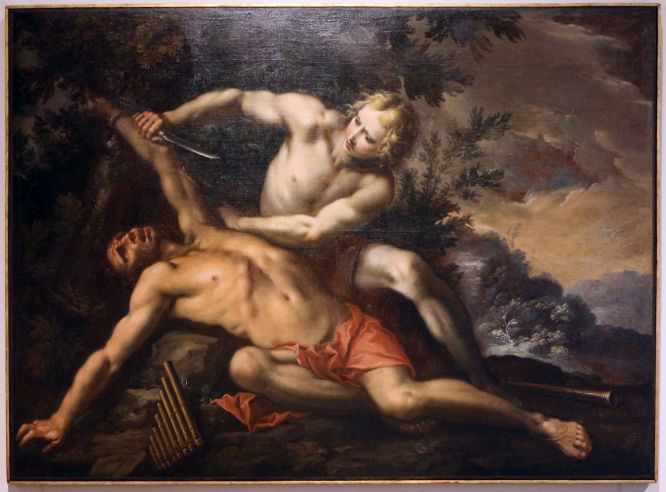
Marsyas screams in agony as he is flayed alive by boyish and rather serene-looking Apollo. On the ground beside the satyr’s outstretched arm lies a syrinx. Behind Apollo’s left leg lies a duct-flute with its characteristic window/labium and slight bell flare. Uniquely among the many depictions of this diabolical scene (including another by Danedi), Apollo has been playing the recorder rather than a stringed instrument, more usual in this context!
References
- Atsma, Aaron J. (2019). THEOI Project. Last accessed 25 April 2023.
- Lander, Nicholas S. 1996–2023. Recorder Home Page: Iconography. Last accessed 11 January 2023.
- Smith, William (1870 / 2014). Dictionary of Greek and Roman Biography and Mythology. 3 vols. : Boston: Little, Brown & Co. / Bellingham: Logos Research Edition.
- Tempest, Pierce & Isaac Fuller 1709. Iconologia or or Moral Emblems by Cæsar Ripa … Benjamin Motte. 1709, London.
- Wikipedia. 2022. Admetus of Therae. Last accessed 11 January 2023.
- Wikipedia. 2022. Apollo. Last accessed 11 January 2023.
- Wikipedia. 2022. Hermes. Last accessed 11 January 2023.
- Wikipedia. 2022. Mercury. Last accessed 11 January 2023.
Cite this article as: Nicholas S. Lander. 1996–2025. Recorder Home Page: Apollo Plays the Recorder. Last accessed 18 December 2025. https://recorderhomepage.net/apollo-as-recorder-player/